Performance and Key Highlights of Bursa Malaysia Derivatives (BMD) Products in Q3 2020

Prepared By : Kenanga Futures Sdn Bhd
Q3 2020 Market Review
Global Highlights
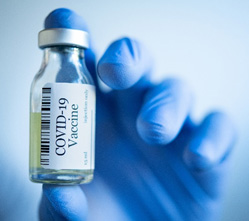
1) COVID-19 Cases Continued to Rise Globally and the Race for Vaccine
- As at end of September 2020, the confirmed cases of COVID-19 have passed 30 million mark globally, while the number of confirmed deaths stood at just over 1 million people.
- According to the World Economic Forum, while the pandemic has spread to 188 countries or regions, the five with the most deaths account for more than half of the global total which are the United States, Brazil, India, Mexico and the United Kingdom.
- In view of the dire impact of this pandemic, dozens of research teams around the world are working to develop a vaccine for this virus and hoped to develop it as early as 2021.
- Billion of dollars are invested in this development with countries like United States, China and Europe investing the most.
- According to medical experts, a vaccine must go through multiple stages before being implemented and the World Health Organisation (WHO) has encouraged countries to cooperate in order to ensure fair global access.
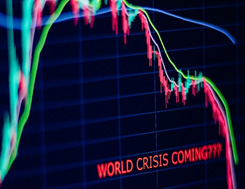
2) The Risk of Global Recession in 2020
- With COVID-19 continuing to spread and the vaccines are yet to be developed, many countries across the globe have slowed down the reopening of economy, causing the potential of global recession in this year.
- World Bank and International Monetary Fund (IMF) have forecasted a 5.2% and 4.4% contraction, respectively, in global GDP in 2020 in their latest economic outlook forecast
- Mirroring the expectation, the World largest economy, United States has registered a contraction of 31.4% annually in its second quarter reading.
- Surprisingly, China has outperformed other G20 members when the country recorded a 3.2% economic growth in April to June period from a year earlier, due to the successful pandemic control in the country.
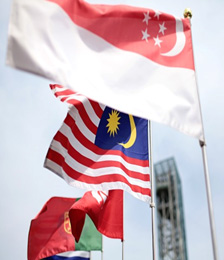
3) Regional Political Development
- Third quarter of this year witnessed many developments happening in Asia Pacific that continue to change the political scene in that region.
- A general election was held in our neighbouring country of Singapore which saw the ruling party of People’s Action Party (PAP) able to maintain their victory, after the party led by Prime Minister Lee Hsien Loong won 83 out of 93 seats in parliament.
- In August 2020, a change of country’s stewardship was seen in Japan when their former Prime Minister, Shinzo Abe, resigned due to health reasons.
- His place was replaced by Yoshihide Suga after winning a poll in Japan’s lower house.
- Back to South East Asia, a political protest occurred in Thailand and Indonesia for a different reason.
- In Thailand, the protest, which actually began last year after the court rule the Future Forward Party (FFP) to disband, demanded the removal of leader Prayuth, a new constitution, an end to the harassment of activist as well as a reform to the monarchy.
- In Indonesia, thousand of demonstrators went to the street to oppose the Omnibus Law proposed by President Jokowi which they think might impacted the working conditions.
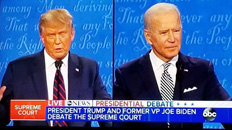
4) US Presidential Election Campaign
- The US presidential election, which is the most awaited political event in a year, is scheduled to happen on 3 November 2020.
- The campaign season had already started when the first presidential debate was held in late September between Donald Trump of Republican and Joe Biden of Democrats.
- Another two round of debates are scheduled to take place in October before the grand Presidential Election on November this year.
Malaysia Highlights
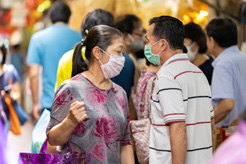
1) The Extension of Recovery Movement Control Order (RMCO)
- Earlier in June, the Prime Minister had already announced the Recovery Movement Control Order (RMCO) to replace the Conditional Movement Control Order (CMCO) as the number of local COVID-19 infections went down.
- The RMCO, which was initiated on 10 June to 31 August, saw most economic sectors allowed to operate at full capacity while adhering to SOPs.
- Nevertheless, for the sake of controlling the transmission of COVID-19, the government has extended the RMCO until the end of the year.
- On top of that, beginning from 1 August 2020, the government has also made the wearing of face coverings in crowded public areas as mandatory.
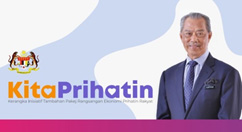
2) An Additional Economic Stimulus Package
- To boost country’s economic recovery, Malaysian government has announced an additional economic stimulus package on 23 September 2020 named as Prihatin Supplementary Initiative Package or Kita Prihatin.
- The package valued at RM10 billion consists of RM7 billion Bantuan Prihatin Nasional (BPN) 2.0, the Wage Subsidy Programme 2.0 worth RM2.4 billion and Prihatin Special Grant (GKP) worth RM600 million

3) Malaysia’s Economic Growth Turned Negative on Second Quarter
- Malaysia’ economy contracted 17.1% year-on-year in the second quarter due to the lockdown measures taken to curb the spread of coronavirus infections, making it the worst economic performance since the Global and Asian Financial Crisis in 2008 and 1997, respectively.
- According to Bank Negara Malaysia’s (BNM) governor, Datuk Nor Shamsiah Mohd Yunus, tourism, manufacturing and investment were among the primary sectors hit by the lockdown.
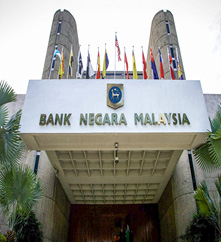
4) The Reduction of Overnight Policy Rate
- Monetary Policy Committee (MPC) meeting were held twice in the third quarter of 2020 on July and September.
- On July 2020, Bank Negara Malaysia (BNM) cut its overnight policy rate (OPR) by 25 basis points (bps) to a record low of 1.75%.
- According to the statement made by the Monetary Policy Committee, the reduction is to provide additional policy stimulus to accelerate the pace of economic recovery as the impact of the pandemic on the global economy is severe and the Malaysia’ economy contracted sharply in the second quarter.
- However, BNM has decided to maintain the OPR at 1.75% in its September meeting citing the continued improvement in the global economy given the easing of containment measures.
- So far, BNM has reduced the OPR four times this year for a cumulative 125bps reduction.
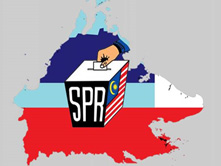
5) Local State Election in Sabah
- Following the dissolution of the State Assembly on 30 July 2020, a snap election was called for a state of Sabah.
- The election took place on 26 September 2020 to elect all 73 elected members of the 16th Sabah State Legislative Assembly.
- The election saw a formation of new state government as the new coalition named as Gabungan Rakyat Sabah (GRS) won by a two-seat majority over Warisan Plus.
- GRS which consisted of Perikatan Nasional and Barisan Nasional won 38 out of 73 seats contested.
Source : Bloomberg, Reuters, The Edge Market and The Star
Overall BMD Performance Q3 2020
No of Trading Days
Q3 2020 : 62
Q2 2020 : 60
Q3 2019 : 61
QoQ Performance
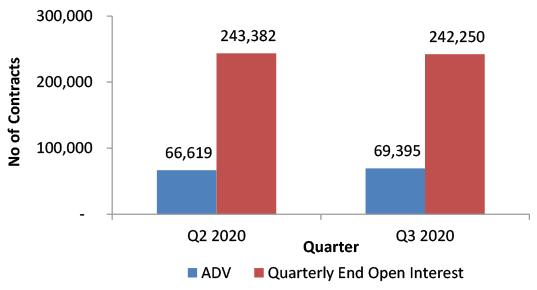
- BMD registered a moderate performance for its ADV growth where the number of contracts grew 4.17% from 66,619 contracts in Q2 2020 to 69,395 contracts in Q3 2020.
- Unfortunately, the quarterly end open interest contracted 0.47% on Q-o-Q basis as the number of contracts reduced from 243,382 contracts in Q2 2020 to 242,250 contracts in Q3 2020.
YoY Performance
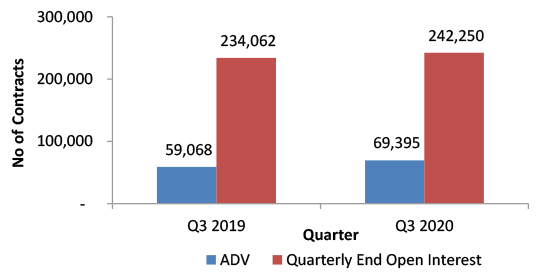
- On Y-o-Y performance, the ADV for BMD expanded relatively well as the number of contracts improved by 17.48% from 59,068 contracts in third quarter last year to 69,395 contracts in third quarter this year.
- Similarly, the quarterly end open interest grew 3.50% from 234,062 contracts in Q3 2019 to 242,250 contracts in Q3 2020.
Source : Bursa Malaysia Website
Overall BMD Market Demography Q3 2020

Review:
- The domination of foreign institution on overall BMD market continued to be seen in third quarter of 2020 as their participation rate hovering around 46% to 48%.
- Domestic retail participants retained their position as the second largest participants in BMD market on third quarter of 2020, having a market share that exceeds 26%.
- Like in the previous quarter, locals and domestic institution maintained their ranking as third and fourth largest participants in BMD market for third quarter of 2020 respectively.
- Meanwhile, foreign retails recorded no participation on overall BMD market for third quarter 2020.
FCPO Performance Q3 2020
No of Trading Days
Q3 2020 : 62
Q2 2020 : 60
Q3 2019 : 61
QoQ Performance
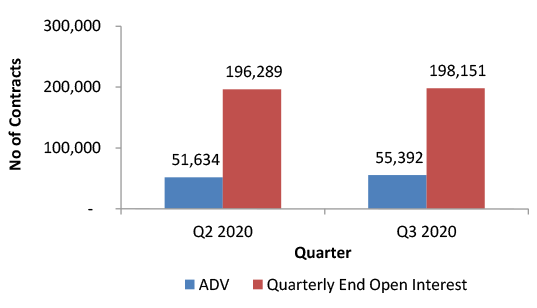
- FCPO continued to be the major contributor for the growth of BMD market in Malaysia as the ADV and quarterly end open interest continued to chart an impressive performance.
- In terms of its ADV, the number of contracts expanded by 7.28% to 55,392 contracts in the third quarter, compared to 51,634 contracts registered in the previous quarter.
- Meanwhile, the quarterly end open interest improved marginally 0.95% from 196,289 contracts in Q2 2020 to 198,151 contracts in Q3 2020.
YoY Performance
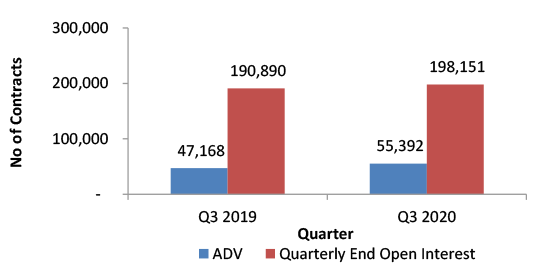
- Similarly, FCPO showed a great improvement in its both ADV and quarterly end open interest when Y-o-Y comparison is made.
- The ADV grew at 17.44% as the number of contracts increased significantly from 47,168 contracts in Q3 2019 to 55,392 contracts in Q3 2020.
- For the quarterly end open interest, the number of contracts increased by 3.80% from 190,890 contracts in Q3 2019 to 198,151 contracts in Q3 2020.
Source : Bursa Malaysia website
FCPO Q3 2020 Price Performance
Snapshot of FCPO Performance
Price as at 30/09/2020 (Last trading day): 2,839
Quarter High: 3,102 (18/09/2020)
Quarter Low: 2,395 (01/07/2020)
Q3 2020 Performance (% Change): +18.54
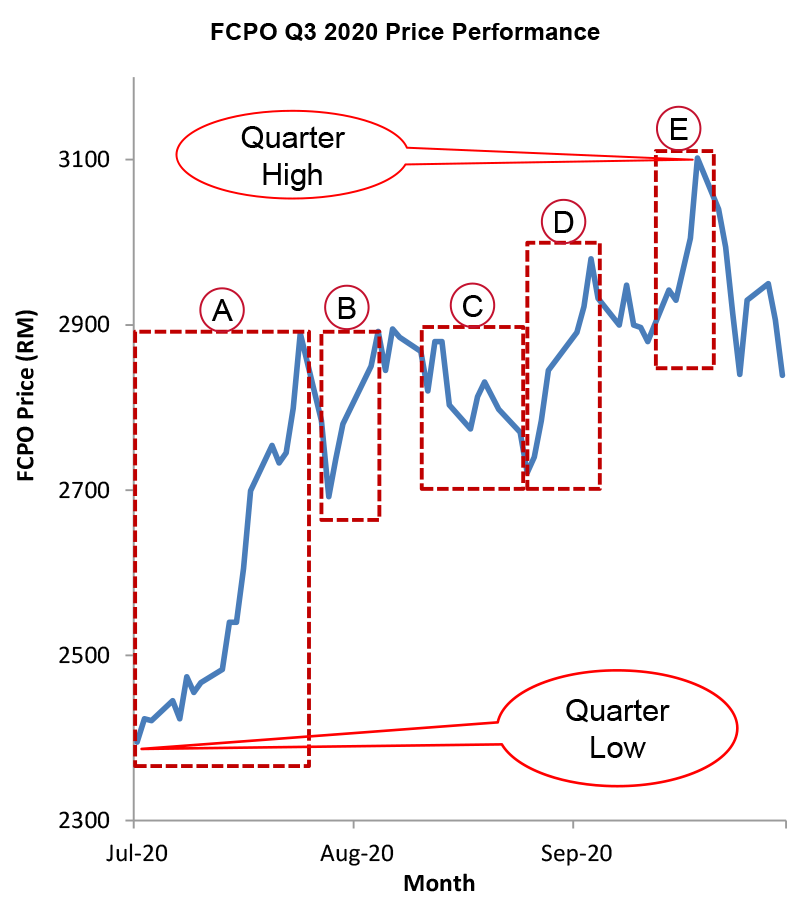
|
Period |
Remarks |
|---|---|
| A |
1 Jul 20 – 24 Jul 20 (+20.67%) FCPO was in an uptrend movement for the first 24 days of July due to the following factors : i)tracking higher prices from crude oil market amid the drawdown in US crude inventories ii)A reduction in Malaysian palm oil inventories for the first 10 days of July at 6.3% iii)Improving in Malaysian palm oil exports for the first 15 days of July iv)Reports of heavy rains in Indonesia and Malaysia that could disrupt the harvesting of palm oil |
|
B |
28 Jul 20 – 4 Aug 20 (+7.43%) The local palm oil market continued to rise on the announcement from Indonesia government to raise the bio-content of its palm oil-based biodiesel to 40% |
|
C |
12 Aug 20 – 25 Aug 20 (-5.52%) FCPO retreated its previous days of gains amid the demand concerns after cargo surveyor showed a decline in early August exports where exports to key destination India has slowed down. |
|
D |
26 Aug 20 – 3 Sep 20 (+8.76%) FCPO recovered from the previous days of losses tracking gains from rival oil markets and on hopes of demand recovery from India ahead of Diwali festival. |
|
E |
11 Sep 20 – 18 Sep 20 (+7.71%) FCPO surged to its highest level in the quarter, supported by the strength in crude and rival oil prices while higher exports in the first half of September also aided sentiment especially from China ahead of the key festival week. |
Source : Bloomberg and The Edge Market
FCPO Market Demography Q3 2020
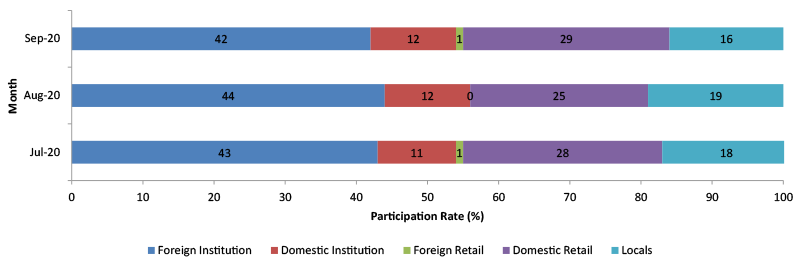
Review:
- The same narrative was seen on FCPO market as foreign institution remained to be the largest participants in Crude Palm Oil futures market in Q3 2020, where its market share was between 42% and 44%.
- Although the participation rate has dropped below than30%, domestic retail participants able to retain their second spot in terms of participanship in FCPO market.
- Behind foreign institution and domestic retail is locals participant which make up a market share between 16% to 19%.
- Meanwhile, the fourth largest participants in the FCPO market for the third quarter of this year is domestic institution with participation rate range between 11% to 12%.
Source : Bursa Malaysia Website
FKLI Performance Q3 2020
No of Trading Days
Q2 2020 : 60
Q1 2020 : 64
Q3 2019 : 61
QoQ Performance
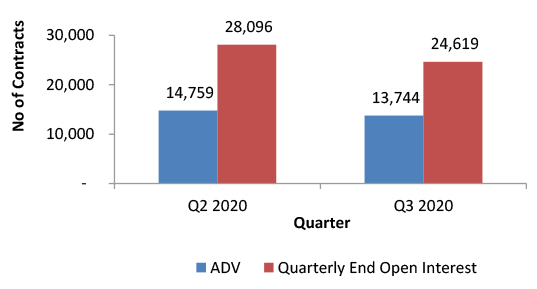
- Unlike the FCPO, FKLI experienced a weaker quarterly performance for both its ADV and quarterly end open interest on Q-o-Q basis.
- The ADV contracted by 6.88% from 14,759 contracts in Q2 2020 to 13,744 contracts in Q3 2020.
- Meanwhile, the quarterly end open interest dropped by 12.38% from 28,096 contracts in second quarter of this year to 24,619 contracts in third quarter this year.
YoY Performance
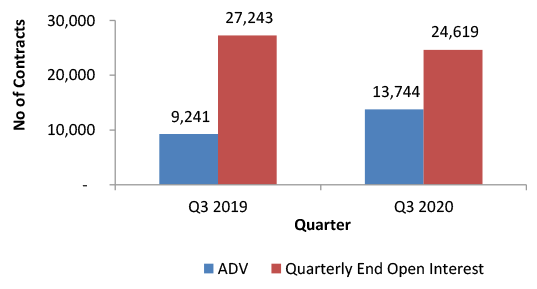
- The number of contracts grew massively at 48.73% for its ADV as the number of contracts improved from 9,241 contracts in third quarter last year to 13,744 contracts in third quarter this year.
- However, the quarterly end open interest dropped by 9.63% from 27,243 contracts in Q3 2019 to 24,619 contracts in Q3 2020.
Source : Bursa Malaysia Website
FKLI Q3 2020 Price Performance
Snapshot of FKLI Performance
Price as at 30/09/2020 (Last trading day): 1,501.5
Quarter High: 1,615.5 (28/07/2020)
Quarter Low: 1,487.5 (10/09/2020)
Q3 2020 Performance (% Change): -0.30
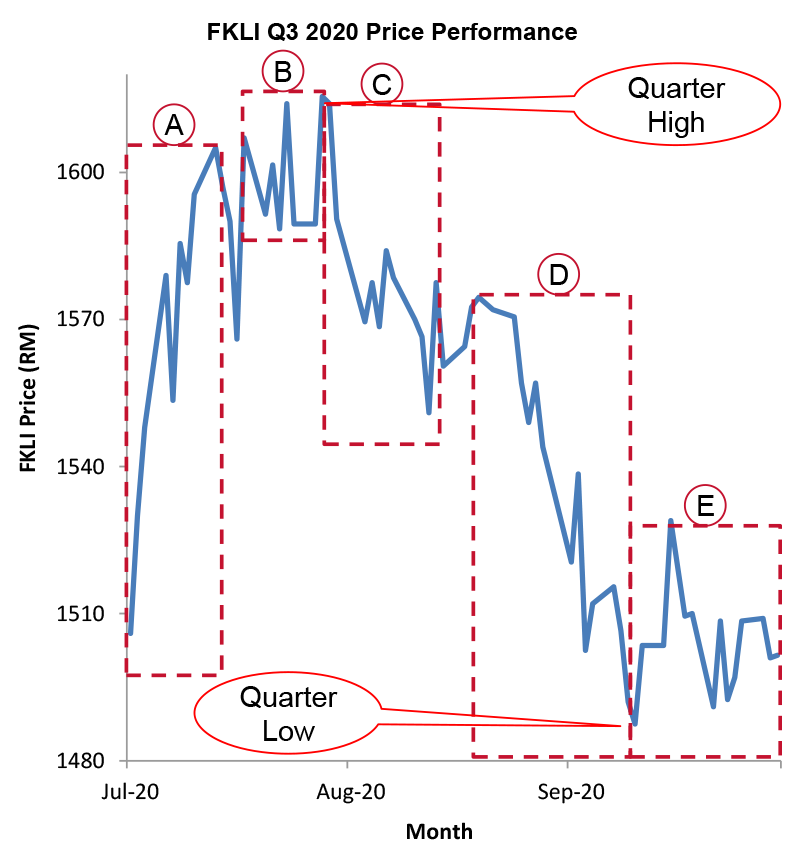
|
Period |
Remarks |
|---|---|
| A |
1 Jul 20 – 13 Jul 20 (+6.57%) FKLI chartered a sharp rise in prices for the first week of July due to the strong buying interest on glove makers’ shares amid the rising global COVID-19 cases. |
|
B |
17 Jul 20 – 28 Jul 20 (+0.53%) Market was traded in a range bound movement as the worries over re-escalation of US-China trade war has outstripped the growing buying momentum of glove makers’ shares which caused the trading volume in Bursa Malaysia rose to record high of 12.5 billion securities. |
|
C |
29 Jul 20 – 12 Aug 20 (-3.90%) FKLI started to retreat from the earlier days of gains in response to the weak Malaysia’s economic performance where according to Bank Negara Malaysia, the GDP in Q2 2020 was contracted by 17.1% from a previous year. |
|
D |
19 Aug 20 – 10 Sep 20 (-5.53%) The local bourse continued to drag down on aggressive profit taking activities on glove makers’ shares |
|
E |
11 Sep 20 – 30 Sep 20 (-0.13%) Market was in a consolidation mode in most part of September as the bargain hunting activities on glove makers’ shares was counterbalanced by several discouraging factors like the dovish stance taken by US Federal Reserve and the rising global COVID-19 cases. |
Source : Bloomberg and The Edge Market
FKLI Market Demography Q3 2020
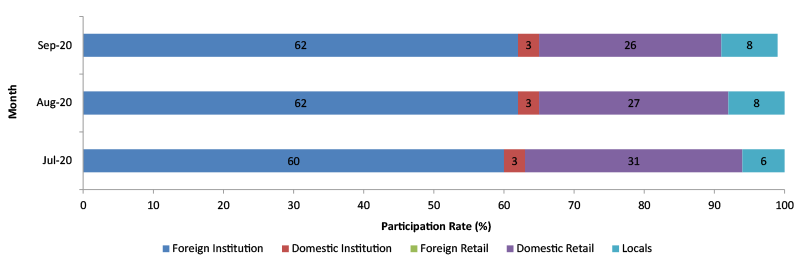
Review:
- Mirroring the FCPO market, foreign institutions continued to the major contributors for trading volume in FKLI market for third quarter of 2020, able to consistently maintain its participation rate above 60%.
- Despite the participation rate was showing declining trend, domestic retail participants retained the second spot in terms of the market share, ranging from 26% to 31%.
- The participation rate for locals, which was the third largest market participants in FKLI market for Q3 2020, dropped to 6% on July 2020, before consistently maintained 8% of the market share on August and September 2020.
- Domestic institution remained to be the fourth largest market participants in the FKLI market with market share maintained at 3% for July to September 2020 period.
Source : Bursa Malaysia Website
Bursa Malaysia Derivatives Q3 2020 Highlights
1
Bursa Excellence Awards 2019
- On 30 July 2020, Bursa Malaysia Berhad hosted its annual Bursa Excellence Awards to honour the top-performing brokers and market intermediaries.
- This year, which marked the 7th edition of the awards ceremony, saw a total of 47 awards in 21 categories were handed out.
- Kenanga Futures (KF) has won two (2) categories which are Best Institutional Derivatives Trading Participant (2nd Runner Up) and Best Trading Participant Equity and Financial Derivatives (Champion).
2
The Relaunch of FMG5 Contracts
- On 18 September 2020, Bursa Malaysia Derivatives (BMD) has successfully relaunched the 5 Year Malaysian Government Securities (MGS) Futures contract known as FMG5.
- To recap, BMD has suspended the trading in FMG5 back on May 2020 in conjunction with exercise taken to revamp the contract specification.
- Following the revamp, the FMG5 contract’s settlement, which was previously cash-settled, is now physically delivered.
- According to BMD statement, the key modification include the role of the Bursa Malaysia Derivatives Clearing Berhad as the central counterparty to facilitate the real-time delivery of the MGS.
Source : The Edge Market
Download full article here
Disclaimer:
The information contained in this material are derived from proprietary and non-proprietary sources deemed by Kenanga Futures Sdn Bhd to be reliable, are not necessarily all-inclusive and are not guaranteed as to accuracy. As such, no warranty of accuracy or reliability is given and no responsibility arising in any other way for errors and omissions (including responsibility to any person by reason of negligence) is accepted by Kenanga Futures Sdn Bhd, its officers, employees or agents.
This material may contain “forward-looking” information that is not purely historical in nature. Such information may include, among other things, projections and forecasts. There is no guarantee that any forecasts made will come to pass. Reliance upon information in this material is at the sole
discretion of the reader.
The information provided here is neither tax nor legal advice. Investors should speak to their tax professional for specific information regarding their tax situation. Trading in listed derivatives involves risk including possible loss of principal.
Prepared by Kenanga Futures Sdn Bhd, a Trading Participant of Bursa Malaysia Derivatives Berhad and a Clearing Participant of Bursa Malaysia Derivatives Clearing Berhad


